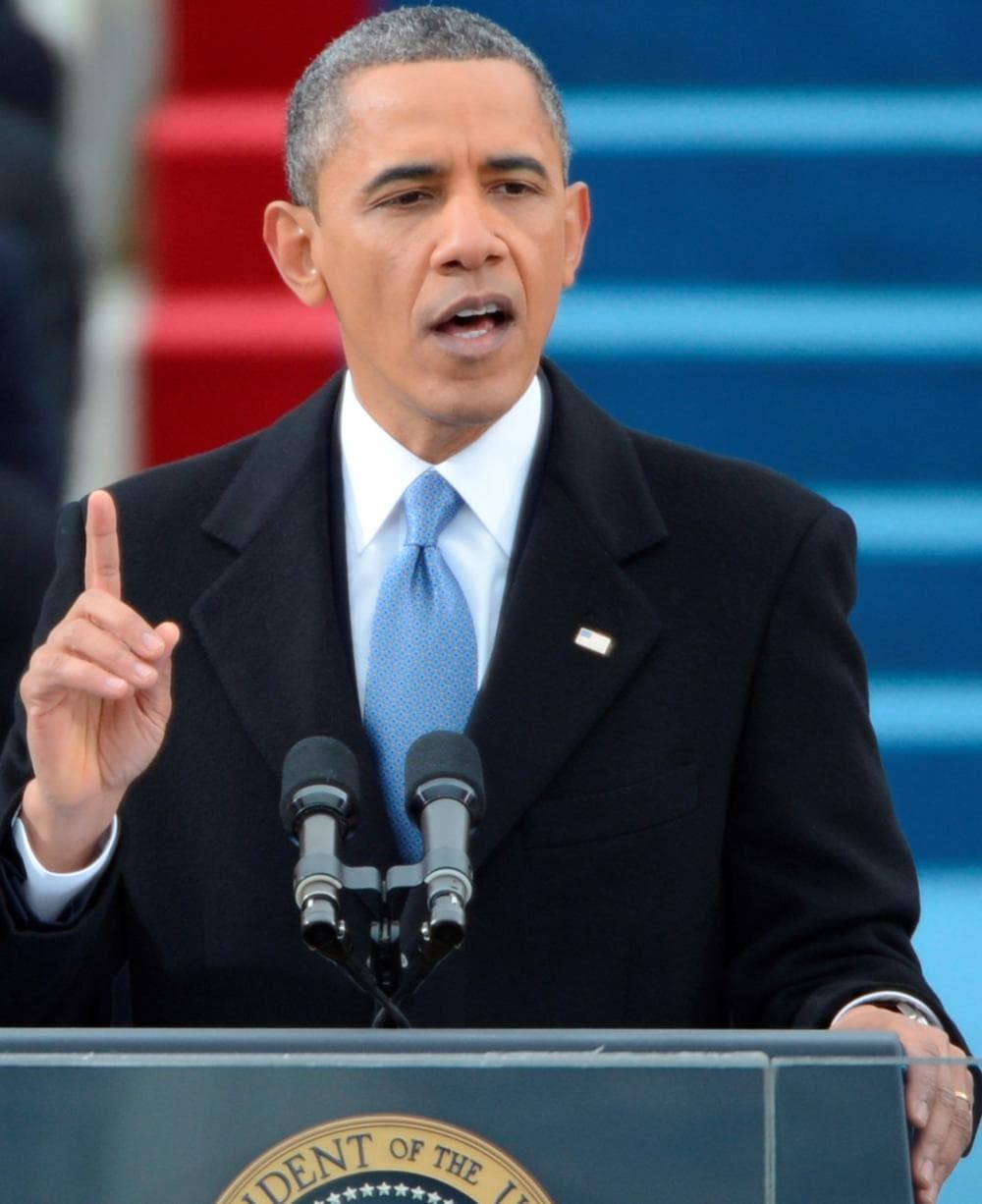Advertisement
Climate Change Series: The Governance Challenge
Introduction
President Barack Obama pledged in his inaugural address on Monday to respond to the threat of climate change, saying: “The path towards sustainable energy sources will be long and sometimes difficult. But Americans cannot resist this transition. We must lead it.”

So, why is addressing climate change so ‘difficult’?
A lot of reasons. But perhaps most significantly: It requires fundamental changes to the way we live and power our lives — changes that some key global industries find threatening. It’s also not universally accepted as science.
Obama, in his address, acknowledged the skepticism: "Some may still deny the overwhelming judgment of science, but none can avoid the devastating impact of raging fires and crippling drought and more powerful storms."
Tufts University professor Bill Moomaw and consultant Sonia Hamel weigh in on the political challenges presented by climate change and, the ways in which governments struggle (with some success) to meet them.

Bill Moomaw is professor of international environmental policy at the Fletcher School of Law and Diplomacy, Tufts University.
In October 1992, four months after President George H. W. Bush returned from an unprecedented meeting of 154 heads of state and government at the Rio Earth Summit, where all signed the United Nations Framework Convention on Climate Change, the United States Senate voted unanimously to ratify the treaty and commit the U.S. to join the global effort to "stabilize greenhouse gas concentrations in the atmosphere at a level that would prevent dangerous anthropogenic interference with the climate system."
In 1997, a few months before the UN meetings in Japan to adopt binding obligations to reduce greenhouse gas emissions, the Senate voted 95-0 in opposition to U.S. adoption of the Kyoto Protocol. The vote marked a complete, 100 percent congressional reversal in just five years. President Clinton signed the agreement, but President George W. Bush “unsigned” the commitment, and the U.S. never joined the other 190 nations who are parties to this agreement.
The Global Climate Coalition, a massive and extraordinarily successful lobbying campaign, helped create the false argument that reducing greenhouse gas emissions would negatively impact economic growth and development.
On December 31, 2012, the emission reduction obligations of the Kyoto Protocol ended. International negotiation efforts to prevent and minimize global climate change have produced only a tentative agreement that we should keep a global temperature rise below 2 C (3.6 F), but future emission reduction commitments only cover 15 percent of global heat trapping emissions.
What went wrong?
The immediate cause was a massive and extraordinarily successful lobbying campaign led by the auto, chemical, coal, natural gas and oil industries under the umbrella of the Global Climate Coalition (an Orwellian-named organization, if ever there was one). The GCC capitalized on — and helped create — the false argument that reducing greenhouse gas emissions would reduce economic growth and development.
The basic approach of diplomats and negotiators working on climate change treaties over the last two decades is a larger failure. They have dealt with global climate change as an economic burden to be shouldered by individual countries, which obscures the future benefits to the global community and the environment.
The current strategy of addressing climate change misdiagnoses the issue as a pollution problem by focusing on symptoms (i.e. greenhouse gas emissions) and not on underlying causes (i.e. a failure to achieve sustainable development). In short, the wrong treaty is being negotiated. Existing and proposed climate treaties fail to meet the national interests of any party, and thus are ineffective even when enacted.
What's needed is an alternative strategy that re-frames the overall approach to addressing climate change so that it reflects the development needs of all countries and links climate protection goals to the development structure of the treaty. The current deadlock over emissions reductions could be overcome by directing international cooperation towards providing clean energy services for development. We know this can work because economic development is what leaders say they want, and none are clamoring for costly pollution reduction.
The 1987 Montreal Protocol on Substances that Deplete the Ozone Layer has been called "the single most successful international agreement to date." It has proven to be a model of cooperation, achieving mutual gains for all parties by meeting the economic development needs of all parties. From the beginning, developing countries were assisted in shifting to substitute technologies already in use by developed countries. Economic incentives were aligned with social goals to protect the ozone layer so that the private sector rapidly developed many replacements for use in refrigeration, insulation and elsewhere. The Montreal Protocol shifted the perception of restrictions on ozone-depleting pollutants from being a burden into an economic development opportunity. As a result, the production of ozone-depleting chemicals — once believed to be essential in many industries — has completely ceased while the global economy continues to grow.
A similar shift in thinking is needed if the community of nations is to address global climate change successfully through international agreements. This can best be accomplished by moving away from the negative burdens of regulating pollution outputs and toward using clean, efficient energy sources and technologies at all levels of development.

Sonia Hamel is an adviser to governments and foundations on energy, transportation, and climate change policy.
In the summer of 2010, U.S. efforts to limit greenhouse gas emissions via a national cap-and-trade system came to a screeching halt, thanks to Senate filibuster rules that require a de facto 60-vote super majority to enact federal legislation. With a Republican House and a slim Democratic majority in the Senate, prospects look bleak for any kind of serious climate change legislation out of Washington in the next several years.
In the words of the great Supreme Court justice Louis Brandeis, a "state may, if its citizens choose, serve as a laboratory; and try novel social and economic experiments without risk to the rest of the country."
Throughout U.S. history, states have led the way on a variety of national policy areas. States have ground-tested policy designs, provided political support, and served as a landing place for implementation programs mandated by federal law. Recent examples include the increasing spread of same-sex marriage laws across the country, and the way in which "Romneycare" — Massachusetts' landmark 2006 universal health care law — served as a model for "Obamacare," scheduled to take full effect nationally in 2014.
States must take the lead: With a Republican House and a slim Democratic majority in the Senate, prospects look bleak for any kind of serious climate change legislation out of Washington in the next several years.
Current state action on climate policy is an extension of this well established paradigm for national policy development. U.S. states are among the largest greenhouse gas emitters and are thus key players in international efforts to reduce emissions. State action is vital to national as well as global progress, and is laying the groundwork for future federal policy development and implementation.
Today, 32 states have climate action plans, 23 have explicit greenhouse gas emissions targets and 27 have renewable energy portfolio standards to encourage the growth of zero emission energy sources. Among the most promising state-initiated programs is the Northeast Regional Greenhouse Gas Initiative (RGGI, pronounced "Reggie"). In 2003, George Pataki, then governor of New York contacted Northeastern states about developing a regional program to reduce power plant carbon dioxide emissions. Nine states, including Massachusetts, have signed on. And in 2009, a cap on carbon dioxide emissions took effect.
Power plants produce about one third of greenhouse gas emissions in the U.S. today. Using a cap-and-trade market system, RGGI is poised to stabilize those emissions in its participating states from 2009 to 2014 and then by 2018, reduce them by 10 percent. With 49 million residents and a $2.4 trillion economy, RGGI states comprise the eighth largest emitter of greenhouse gases in the world.
Largely thanks to energy efficiency measures paid for by auction proceeds — RGGI ends up saving the average residential consumer $25 per year. The average commercial customer saves about $181 and the average industrial consumer saves about $2,500.
Overall, RGGI has saved electric customers some $1.3 billion, and generated $1.6 billion in net economic benefits to the Northeast and Mid-Atlantic regions. In addition, the reduced demand for energy means the states will keep $765 million in the local economy that would otherwise have been used to buy fossil fuels.
RGGI is proving — as are other state and regional initiatives — that programs for capping and cutting greenhouse gas emissions have short-term economic benefits that can match or exceed their costs. In doing so, they are laying the groundwork necessary for far-reaching and effective national climate change policy. Other states have been considering similar programs and California has begun an economy-wide cap-and-trade program that has only recently begun but already is far more ambitious than RGGI and will build the next step in demonstrating a wide market solution for climate change.
Besides cap-and-trade, a suite of renewable energy and efficiency policies and programs are flourishing. These, in the long run, will help to reduce emissions, at least to manage growth, if not to meet deeper reductions. Still, additional federal policies and programs will be needed to guide the efforts of non-participating states, and to create a level playing field and lead to deeper reductions.
Related:
- WATCH video of these lectures — plus a Q & A with Bill Moomaw and Sonia Hamel — here.
This program aired on January 23, 2013. The audio for this program is not available.